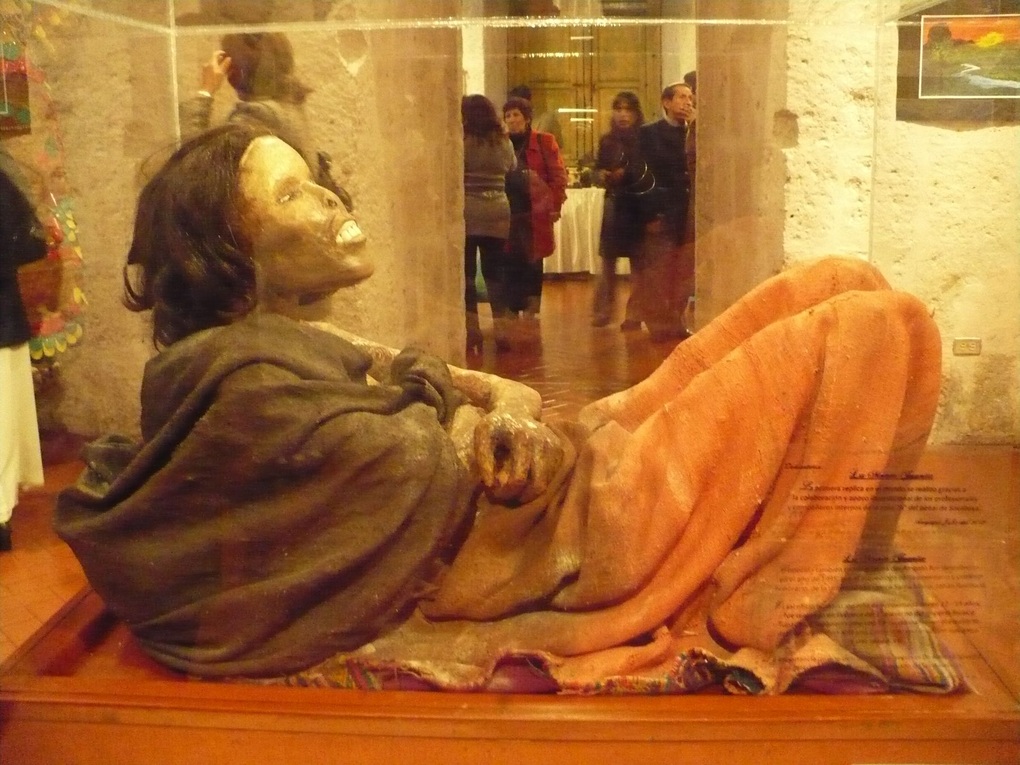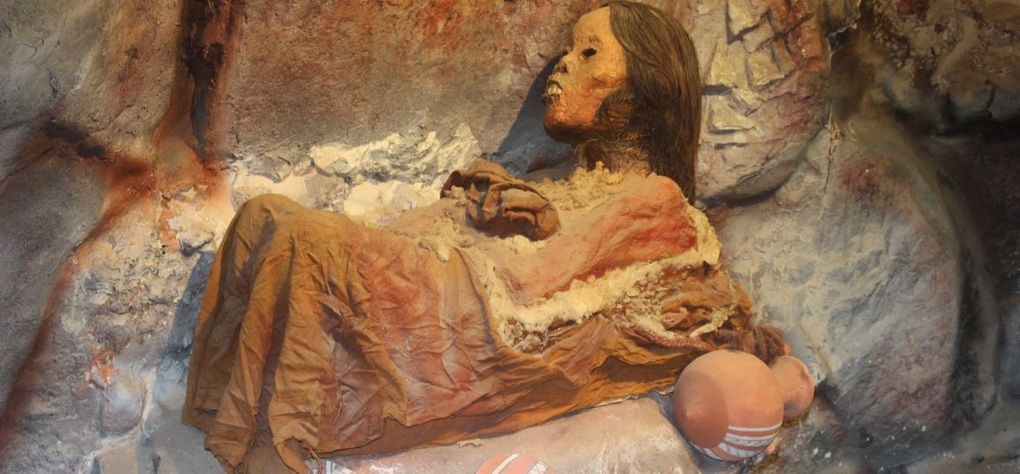The must-see attraction for tourists when visiting the Museo Santuarios Andinos (Andean Sanctuary Museum) in the city of Arequipa, Peru, is definitely Juanita’s mummy. This is one of the best preserved mummies in the world today.

All of the black hair on the deceased’s head was almost intact. The skin on the arms is hardly decomposed. Johan Reinhard, the person who discovered this mummy, even described the skin as “so perfectly preserved that the hairs can be clearly seen”.
But unlike her peaceful appearance when she “closed her eyes and gave up”, archaeologists discovered that the short life of young woman Juanita ended in an “unbelievably terrible” way. Because this young woman is a “sacrificial product” to the Inca Gods.
500-year-old mummy was found in a “newly deceased” condition
In 1992, Peruvian climber Miguel Zárate led an expedition to Mount Ampato at an altitude of 6,288 m. He suddenly found strange pieces of wood on the top of a snow-capped mountain, so he suspected this could be an archaeological site.
Ampato is a volcano in the Andes range, covered all year round with white snow more than 9 meters thick due to very harsh weather. But then, due to the impact of the volcanic eruption, the snow and ice layer on the mountainside that had been frozen for thousands of years melted. Thanks to that, the secret that was buried hundreds of years ago was revealed.
After the volcanic eruption, in September 1995, climber Miguel Zárate persuaded American archaeologist Johan Reinhard to join him in conquering Mount Ampato.

Here, an American archaeologist discovered the secret under the seemingly eternal layer of snow and ice. Many archaeological relics were found, but the place that received the most attention was a tomb on the side of a mountain. This is the resting place of a young girl about 12-15 years old. The mummy is perfectly preserved and almost intact with a calm face, not showing any panic before death.
This is not the first mummy found in the Andes, but it is the first female mummy to be unearthed. For this special reason, experts also gave it a beautiful name – Juanita.
Based on the remote location of the tomb and the remaining sacrificial objects around, archaeologists believe that Juanita was sacrificed to the Inca Gods on the top of the mountain.
This is a traditional custom of indigenous people. They believe that this ritual is a way to “appease the Gods, prevent natural disasters” or “ensure a good harvest”. The sacrifice of young women like Juanita is inevitable because “it affects the issue of belief and worship on the sacred mountains of the Incas”.
It took several days for the expedition to bring the frozen mummy to the village of Cabanaconde. Here, the body was placed in a specialized freezer and then transported to Católica University in Arequipa city for examination.
In an interview conducted in 1999, American archaeologist Reinhard shared: “When analyzing, experts were surprised and said that Juanita did not look like a 500-year-old mummy, but as if she had just died a few weeks ago. “.
Unexpected discoveries about death
It was not unusual in Inca culture for young women to be chosen as sacrifices to the gods . Juanita’s short life ended in a sacrifice.
But the days before the girl died were very different from the life of an ordinary Inca girl. Experts analyzed DNA from Juaita’s hair, thereby finding out her diet before being sacrificed.

Hair analysis results showed that Juanita was chosen as a sacrifice about a year before her death. From a diet that only consisted of vegetables and potatoes, she was switched to eating more premium foods, including animal protein and large amounts of coca leaves as well as alcohol.
Andrew Wilson, a forensic and archaeological expert, explained to National Geographic, “The final six to eight weeks of the sacrificed maidens were in a very intoxicated state due to chemical changes from coca leaves and Chicha wine”.
Therefore, archaeologists believe that before the sacrificed people died, they were in a “very comfortable” state. Thanks to enjoying a mixture of drugs and alcohol, plus the high altitude in the mountains, the “sacrificial children” soon fell into eternal sleep. But Juanita was not so lucky.
500 years later, the horrifying truth is revealed
Dowsing expert Elliot Fishman discovered that this Peruvian girl’s death was caused by severe bleeding. It was a blow with a stick that had a huge impact on the head. After the fatal blow, the girl’s skull was swollen and hematoma pushed her brain to one side. And this blow also ended the life of the sacrificial girl.
After her death between 1450 and 1480, Juanita stayed alone in the mountains for 500 years. If the volcano did not erupt, it is possible that the young girl’s mummy would continue to be buried on the frozen mountain top for many more centuries.
But volcanic activity causes the permanent snow and ice to melt. The snow covering Ampato Mountain melted, pushing Juanita’s tightly wrapped mummy and burial site down the mountain. And finally, in May 1995, Johan Reinhard’s archaeological team found her body.
Juanita’s mummy was preserved in an almost intact state, causing a stir among experts and public opinion. The body is considered the best preserved mummy in the Americas.
The main reason is that it was trapped under 9 m thick ice for hundreds of years. The cold climate prevented decomposition of the body because most strains of bacteria and fungi do not survive in such harsh conditions.
According to Sonia Elizabeth Guillén, a leading expert on mummies in Peru, finding Juanita’s body is of great significance to archeology. “We can collect and research a lot of data about ethnological history and archeology through analyzing the DNA and blood clots of this mummy,” he commented.
After that, the American archaeologist also returned to Ampato peak with a powerful expedition team. Here, they continued to discover two more child mummies, including a boy and a girl. These are also “sacrificial babies” for the Gods. Experts estimate that hundreds of Inca children may have been mummified on mountain peaks in the Andes, still waiting to be discovered.
During the period from 1996 to 1999, this archaeologist also found 14 other Inca mummies. Thereby, opening up new knowledge of a civilization.
Today, when visiting the Museo Santuarios Andinos – where Juanita’s body is preserved, visitors will pass through a series of rooms containing artifacts found during the expedition to find the mummy.
From January to April, Juanita will be moved to another area, frozen deep in complete darkness for conservation purposes.